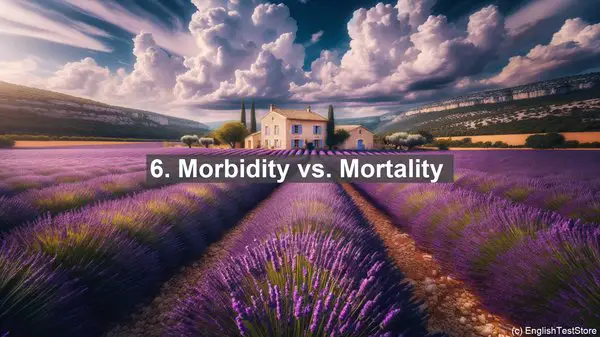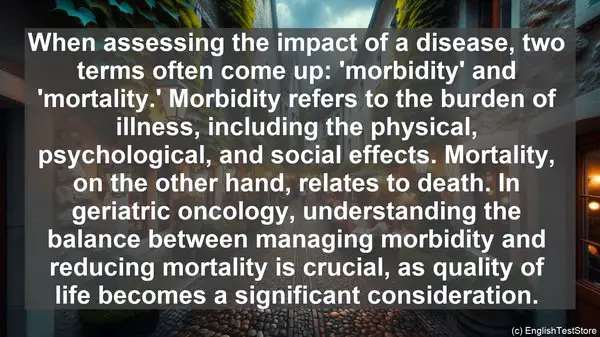Introduction
Today, we’re diving into the world of geriatric oncology. As you progress in your medical studies, it’s crucial to grasp the nuances of medical terminology. In this lesson, we’ll focus on the top 10 commonly confused words in this specialized field. Let’s get started!
1. Palliative vs. Curative
The first pair of words that often cause confusion are ‘palliative’ and ‘curative.’ While both relate to treatment, they differ in their goals. Palliative care aims to improve the patient’s quality of life, managing symptoms and providing comfort, especially in advanced stages. On the other hand, curative treatment intends to eliminate the disease or achieve remission. Understanding when to prioritize one over the other is vital in geriatric oncology, where symptom management often plays a significant role.
2. Metastasis vs. Migration
Next, let’s clarify the difference between ‘metastasis’ and ‘migration.’ Metastasis refers to the spread of cancer cells from the primary site to other parts of the body, often through the bloodstream or lymphatic system. Migration, however, is a broader term that can describe the movement of cells, including normal ones, within an organism. In geriatric oncology, understanding the mechanisms of metastasis is crucial for determining the stage and prognosis of cancer.
3. Benign vs. Malignant
When discussing tumors, ‘benign’ and ‘malignant’ are frequently used. A benign tumor is non-cancerous, often localized, and unlikely to spread. In contrast, a malignant tumor is cancerous, invasive, and can metastasize. Distinguishing between the two is essential for determining the appropriate course of action, whether it’s surgical removal for a benign tumor or a more comprehensive treatment plan for a malignant one.
4. Remission vs. Cure
While ‘remission’ and ‘cure’ both indicate positive outcomes, they have distinct meanings. Remission refers to a period when the signs and symptoms of a disease are reduced or absent. It’s possible to achieve remission in cancer, but that doesn’t guarantee a cure. Cure, on the other hand, implies the complete eradication of the disease, with no chance of recurrence. Understanding these terms is crucial for setting realistic expectations and communicating with patients.
5. Prognosis vs. Diagnosis
In geriatric oncology, ‘prognosis’ and ‘diagnosis’ are two fundamental aspects. Diagnosis involves identifying the disease, often through tests and examinations. Prognosis, on the other hand, focuses on predicting the course and outcome of the disease. A positive prognosis indicates a favorable outcome, while a negative one suggests challenges ahead. Both factors play a role in treatment decisions and patient counseling.
6. Morbidity vs. Mortality
When assessing the impact of a disease, two terms often come up: ‘morbidity’ and ‘mortality.’ Morbidity refers to the burden of illness, including the physical, psychological, and social effects. Mortality, on the other hand, relates to death. In geriatric oncology, understanding the balance between managing morbidity and reducing mortality is crucial, as quality of life becomes a significant consideration.

7. Adjuvant vs. Neoadjuvant
In cancer treatment, ‘adjuvant’ and ‘neoadjuvant’ therapies are used to complement the primary treatment, often surgery. Adjuvant therapy is given after the primary treatment to reduce the risk of recurrence. Neoadjuvant therapy, on the other hand, is administered before the primary treatment, with the goal of shrinking the tumor or making it more manageable. Understanding the timing and purpose of these therapies is vital in geriatric oncology.

8. Prophylactic vs. Therapeutic
Two terms often used in the context of preventive medicine are ‘prophylactic’ and ‘therapeutic.’ Prophylactic measures aim to prevent the occurrence of a disease or condition. Vaccinations are a classic example. Therapeutic interventions, on the other hand, are intended to treat an existing disease. In geriatric oncology, a comprehensive approach often involves a combination of both, with preventive measures playing a crucial role.
9. Invasive vs. In-situ
When describing the extent of cancer, ‘invasive’ and ‘in-situ’ are commonly used. Invasive cancer refers to malignant cells that have penetrated surrounding tissues or organs. In-situ, on the other hand, indicates that the abnormal cells are confined to their site of origin, without invasion. Understanding the extent of cancer is vital for determining the appropriate treatment approach and predicting outcomes.
10. Etiology vs. Pathogenesis
Finally, let’s differentiate between ‘etiology’ and ‘pathogenesis.’ Etiology refers to the cause or origin of a disease. It can be multifactorial, involving genetic, environmental, and lifestyle factors. Pathogenesis, on the other hand, focuses on the development and progression of the disease. In geriatric oncology, understanding both aspects is crucial for prevention, early detection, and targeted treatment strategies.
